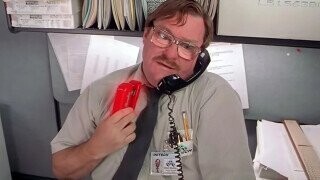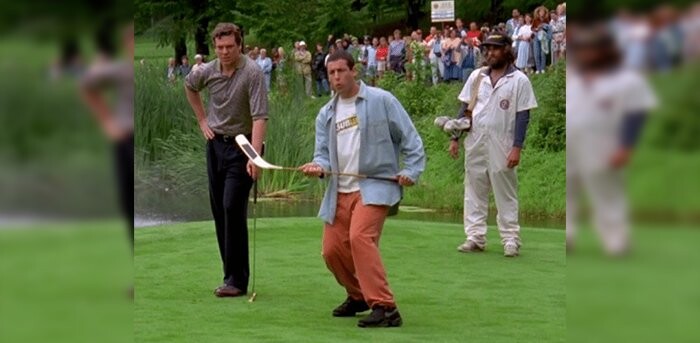The Origins Of 15 Iconic Comedy Movie Props

Props make the movie…literally. In a comedy, a great prop can be the source of hundreds of jokes, or be a joke in itself, so it's important that they're up to snuff. Here are 15 backstories of some of the most memorable props in comedies.
Big Ern's Bowling Ball: Kingpin

MGM
Peter Farrelly, the director of Kingpin, said they stumbled onto the rose ball while location scouting old Pittsburgh bowling alleys for the movie. Farrelly saw the ball on the shelf and immediately bought it for Big Ern. Murray was tickled by the ball according to Farrelly, and the ball now lives in Kings Alley in Boston Massachusetts on their Kingpin wall.
The Hockey Stick Putter: Happy Gilmore

Universal Pictures
There were no putters with hockey stick ends back in that day, according to production designer Perry Blake, so they had to make the putter from scratch. The hardest part of the design was that Sandler wanted to have a “prove-it” shot where he sinks a put with the hockey putter from 25ft away, so it had to be functional in addition to comical. On the day of the scene, Blake says everyone was waiting with bated breath for Sandler to sink his put after several tries, and when he eventually nailed it everyone cheered.
The Fuzzy Pen: Legally Blonde

MGM
Director Robert Luketic had a religious experience as soon as he saw the fuzzy pen. He said, “This pen was brought to my attention by my art department. My eye went immediately to the pink puffy ball. I had never seen anything like it. That was the pen you bring to the first day of Harvard Law. She did things on her own terms, in her own way and her own world. She wasn't going to conform. That pen said it all. And it's something the writers and I hear about all the time: 'The movie encouraged me to go to law school. Look at me, I can still be who I want to be.' Women say it was empowering and freeing. And slapped me in the face. It was so apparent."
The Alarm Clock: Groundhog Day
Amie McCarthy-Winn, prop master for Groundhog Day, said Harold Ramis’s only stipulation was that the props had to work. McCarthy-Winn found the perfect original clock at a flea market in Sandwich, Illinois. Since the clock was so unique, she could only find one other working model as a backup, and nine or ten non-working models were made for more backups of the backup.
The Leg Lamp: A Christmas Story

MGM
The production designer Reuben Freed told Ohio Magazine “The term 'leg lamp' is Jean ’s invention. I got a mannequin leg and asked costume designer Mary McLeod for input. She brought me a single pump, and I added fishnet stockings because that’s what a bad girl would wear. For the lampshade, I drew on an image from a comic book that had a '40s look to it. That was the easy part. The difficulty was creating something that would break on command, that we could have more than one of, that could be electrified and stand by itself."
Amps Up To 11: This Is Spinal Tap
Like many of Guest’s mockumentaries, there are no scripts, only outlines, which is exactly what production designer Bryan Jones received. In the scene where Nigel shows off his guitars, Jones had free reign, and collected all the unique guitars from “Norm’s Rare Guitars.” For the amps that go to 11 he went to Ray Johnson Studio and had them make custom plates for the dials that went up to 11.
Otto Pilot: Airplane!
David Zucker the co-director/co-writer of Airplane! says the idea started just from sketching a cliche pilot in blow-up form. The art department then created the models that could be connected to an air machine and blown up/deflated as quickly or slowly as the directors wanted. The idea of the “winking” from the doll came from a grip on set, according to Zucker.
Sex Panther: Anchorman
Scott Maginnis, the prop master on Anchorman, said to make the sex panther box he bought a humidor for storing cigars, lined it with Astroturf, and made a tiny elevator for the panther to pop up in. On shoot day, however, the focus-pull frequency for the camera and the frequency for the panther elevator were tripping each other up, making it appear “jerky.” Adam McKay ended up thinking the jerky takes were funnier.
The Red Stapler: Office Space

20th Century Studios
Did you know that Mike Judge, director of Office Space invented the red stapler? According to Judge, he wanted a stapler that would stand out among the greys and blues of the cubicles, so he had the props department paint one red and slap “Swingline” on the side of it. Swingline only started making red staplers after so many people called the company to request them, and fakes started popping up on eBay.
Spaceballs The Flame Thrower
Dennis Parrish, prop master of Spaceballs was told by Mel Brooks to go crazy with making a ton of “Spaceballs: The’ items. Parrish says he came up with twice as many props as scripted and made the flamethrower using a juiced-up weed burner.
The McLovin ID: Superbad

Apatow Productions
Production designer Chris L. Spellman only knew that he had to make a fake ID for McLovin, but because he had just finished a movie in Hawaii, he suggested Hawaii be the state on the card. Seth laughed at the idea and said “Yeah, let's make him from Hawaii.”
The Little Tramp's Cane: Charlie Chaplin
In Charlie Chaplin’s 1964 autobiography, he recounts how he found his most famous character, The Little Tramp, through props. He was told to put together a comedy act immediately for a scene, so he went to wardrobe to figure something out. He said, “ I would dress in baggy pants, big shoes, a cane and a derby hat. I wanted everything a contradiction: the pants baggy, the coat tight, the hat small, and the shoes large. I added a small mustache, which, I reasoned, would add age without hiding my expression.”
"I had no idea of the character. But the moment I was dressed, the clothes and the make-up made me feel the person he was. I began to know him. When I confronted Sennett I assumed the character and strutted about, swinging my cane and parading before him. Gags and comedy ideas went racing through my mind."
The Hamburger Phone: Juno

Searchlight Pictures
Steve Saklad, the Juno production designer, said the hamburger phone was in the very first version of the script Diablo Cody wrote. They found the phone on a Chinese toy website and tried to have it shipped to Canada, but it was stopped in customs due to a ban on shipping toys from China to Vancouver. Instead, the phone was shipped to the US and driven into Canada. Saklad says the phone is so memorable because, “It's this innate kid thing crashing into a completely adult challenge, adult problem -- that's why it works so brilliantly.”
The Giant Joint: Cheech and Chong's Up in Smoke

Universal
In the early years, Cheech and Chong would mime their humongous joints for comedic effect at their live shows. When it came time to make the movie, however, they got the chance to make the real thing. According to Chong, “ pretty horrible. We weren't using real weed, we were using an herbal mixture and it wasn't that tasty. That big joint was like our trademark, and it still is. We've been on the road for years and especially since weed has been legalized, we have fans coming up and presenting us with giant joints all the time. And we accept them, too."
The Coconuts: Monty Python and The Holy Grail

Python (Monty) Pictures
In The Pythons: An Autobiography By The Pythons, Terry Jones explains, "The coconut gag was the original gag that sparked the whole thing off. We did talk about having horses at one point and then we quickly dismissed it because we thought it be funnier not to and because we couldn't afford horses anyway."
For exclusive ComedyNerd content and more, subscribe to our spiffy newsletter:
Top Image: Columbia Pictures
